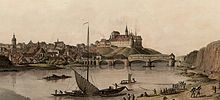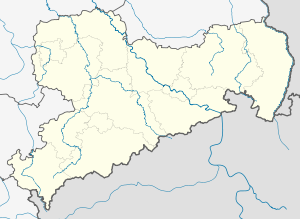Meissen Old Town Bridge
Coordinates: 51 ° 9 ′ 52 ″ N , 13 ° 28 ′ 36 ″ E
| S 177 old town bridge Meißen | ||
|---|---|---|
| Convicted | State Road 177 | |
| Subjugated | Elbe , km 82.2 | |
| place | Meissen | |
| construction | Composite steel bridge | |
| overall length | 204.7 m | |
| width | 18.1 m | |
| Longest span | 61.2 m | |
| Construction height | 1.63 m to 2.5 m | |
| Clear height | 6.36 m at HSW | |
| building-costs | 12 million DM | |
| start of building | 1999 | |
| completion | 2000 | |
| location | ||
|
|
||
The old town bridge in Meißen is a 205 m long road bridge that spans the Elbe at river kilometer 82.2. It crosses State Road 177 with three lanes as well as sidewalks and cycle paths arranged on both sides and serves as a connection between the old town of Meissen and the districts on the right bank of the Elbe.
history
Earlier bridge construction

The first fixed Elbe crossing was built from 1160 in Meißen at the foot of the Burgberg as a wooden structure. It was first mentioned in a document in 1291. However, in the centuries that followed, ice or floods repeatedly destroyed the wooden bridges at this location. The settlement on the right bridgehead still bears the name Vorbrücke today . In the period from 1443 to 1463, a covered timber framework bridge was built on stone pillars with main spans in the current range of 40 m and 50 m. Nevertheless, the building was set on fire in various wars, for example in the Schmalkaldic War in 1547 , in the Thirty Years War in 1637 , in the Seven Years War in 1757 and after the Russian campaign on March 13, 1813 on the orders of the French General Louis-Nicolas Davout .
Until the opening of the railway bridge in Riesa in 1839, the bridge in Meißen was the only bridge between Dresden ( Augustusbrücke ) and Torgau .
From 1815 to 1866 the superstructure consisted of wooden trusses. The trusses were boarded in such a way that the shape and painted joints gave the impression of a stone vault bridge. On June 15, 1866, during the invasion of Prussian troops , Saxon units blew up the third pillar of the bridge. When the bridge was rebuilt in 1867, an iron lattice girder was installed as a superstructure for the first time.
New building from 1934
Since 1889, the Meißner Rat at the Royal Ministry of Finance, the authority responsible for the bridge since 1814, tried to build a completely new bridge. In 1914 an upcoming new bridge was postponed due to the outbreak of war. Two ideas competitions followed in the 1920s, and the decision to build it was taken in December 1932. The new building finally followed in the years 1933 to 1934 when a 202.5 m long deck bridge was built due to the bridge competition from 1929. The superstructure of the riveted steel construction consisted of solid wall girders in the longitudinal direction , on which cross girders and secondary longitudinal girders supported the reinforced concrete deck. The abutments and pillars were concreted and clad with red Meißner granite . The use for the tram was not intended for the new building.
The new bridge was partially opened to traffic on June 5, 1934, and the demolition of the old bridge began on the following day. Since the bridge was built as part of job creation measures from the time of the Weimar Republic , the local NSDAP leadership was not ready for a ceremonial inauguration on the day of the complete handover of the structure, November 17, 1934. Presumably for the same reason, the Reich Chancellery rejected the designation Adolf Hitler Bridge in 1935 .
On April 26, 1945 the outer and an adjoining inner bridge field were destroyed by a demolition by the Wehrmacht. In June of the same year, the new city administration and the Central German steelworks Lauchhammer / Riesa took up the initiative to repair the bridge. As early as January 31, 1946, the structure was repaired to the point that it could be driven on again, and the opening was celebrated on February 3. In 1954 it was named "Bridge of German-Soviet Friendship".
Bridge from 2000
Inadequate structural maintenance led to major corrosion damage to the bridge in the following decades . In 1991 the pavement of the road was replaced by a bituminous road surface and a steel sheet with an epoxy resin coating was installed in the sidewalk area as an alternative. Since these measures did not have lasting success and due to the existing damage, the entire bridge superstructure was finally replaced between the years 1999 and 2000 by a new building with a similar type of construction. The substructures could continue to be used after repairs.
The bridge could not be opened to traffic as planned on December 17, 1999, but only on July 24, 2000. The main reasons were the unplanned finding of listed components and a longer period of low water on the Elbe, which meant that a floating crane from Rotterdam was not used as planned. This suffered an average at Riesa . In a first step, the old superstructure was dismantled. In the next step, the new steel construction was lifted in five assembly stages, weighing up to 76 t, with a floating crane from the beginning of February 2000. The girder assembly of the left edge field was carried out from the bank with a truck crane. This was followed by the construction of the reinforced concrete deck slab in sections with a formwork carriage in lengths of approximately 18.2 m. The prestressed concrete bridges were concreted on a falsework .
description
The five-span, 204.71 m long road bridge is a steel composite structure with spans of 51.35 m, 61.20 m and 51.35 m. The edge fields with spans of 20.07 m or 20.74 m are prestressed concrete components due to the complicated ground plan geometries with widening .
The superstructure of the power fields, a three-web T-beam, is supported by steel longitudinal girders with a center distance of 6.3 m, which are connected by headed bolt dowels to the reinforced concrete deck slab, with a variable cross-section height, on average 33 cm thick and 18.1 m wide . Cross beams connect the main beams above the supports and in the fields. In the river area there is a clear height of 6.36 m at the highest navigable water level.
Individual evidence
- ↑ a b c d Steffen Förster: Elbe crossing shaped the city's history . In: Meißner Tageblatt No. 11, June 4, 2009, p. 8
- ^ Meißen time table
- ^ Dresden Waterways and Shipping Office
literature
- BMVBW : Bridges and tunnels on the federal trunk roads 2001 . Deutscher Bundes-Verlag, Bonn, pp. 109–115, ISBN 3-935064-09-8 .
- Erich Fiedler: Road bridges over the Elbe . Saxoprint, Dresden 2005, ISBN 3-9808879-6-0 .
- Paul Goldhardt: Meissen and its new bridge. in: Communications of the Landesverein Sächsischer Heimatschutz Volume XVIII, Issue 3–4 / 1929, Dresden 1929, pp. 174–180
- Gisela Helbig: Meissen's old Elbe bridge . in: Sächsische Heimatblätter 35 (1989) 1, pp. 1-3
Web links
| upstream | Bridges over the Elbe | downstream |
| Elbe bridge Meißen (railway) | Meissen Old Town Bridge |
New Elbe bridge in Meissen |




